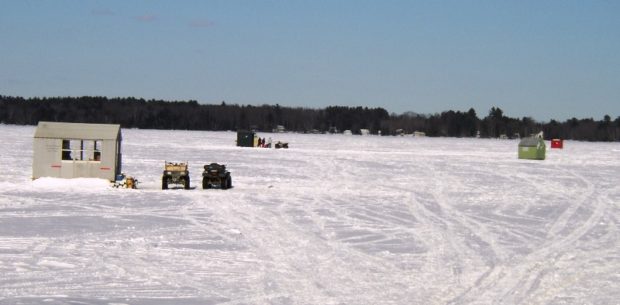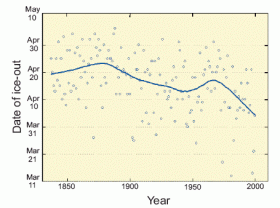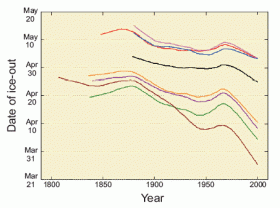
Ice fishing is facing 15 fewer days on the lakes since the late 19th century.
Historical Changes in Lake Ice-Out Dates as Indicators of Climate Change in New England, 1850-2000
U.S. Department of the Interior, U.S. Geological Survey Fact Sheet FS 2005-3002 January 2005.
Changes in water resources over time may affect public and private water supplies and the health of aquatic ecosystems. The U.S. Geological Survey is studying the relation between climate and water-resource variables in Maine and New England to provide resource managers, the scientific community, and the public with better information about the sensitivity of water resources to climate change and variability. The long-term collection and availability of high-quality water-resources data are crucial to these efforts.
Introduction
Lake ice-out dates, or the dates of ice break-up, are the annual dates in spring when winter ice cover leaves a lake. Several studies in the last 15 years have used lake ice-out dates in the Northern Hemisphere as measures of climatic variability and change. Very few lakes in New England have been analyzed, even though a remarkable amount of lake ice-out data have been recorded and saved in New England during the past two centuries. For some lakes in New England, such as Moosehead Lake, ice-out dates were important for local steamship transportation. Data from other lakes, such as Richardson Lake, were important for annual log drives. Individuals have collected and saved extensive data because of general curiosity and community interest. For Damariscotta and West Grand Lakes, the same family has been collecting ice-out data for three generations. The purpose of this study was to document and analyze the historical lake iceout dates in New England.
Key Findings
Ice-out dates from 29 lakes in New England with 64 to 163 years of record were assembled and analyzed for this study (Hodgkins and James, 2002; Hodgkins and others, 2002). Twenty-two of these lakes are in Maine, four are in New Hampshire, and three are in Massachusetts.
Ice-out dates have become significantly earlier in New England since the 1800’s. Ice-out dates changed between 1850 and 2000 by 9 days in northern and mountainous areas of New England (primarily northern and western Maine) and by 16 days in more southerly locations (figs. 1 and 2). Changes in the ice-out dates over time were very consistent between lakes within each of these two areas of New England.
Of the ice-out dates for the eight lakes in New England with the longest periods of record, the top four lines are lakes in northern and western Maine; the bottom four lines are lakes in southern Maine.
About half of the year-to-year variability in the lake ice-out dates is explained by historical March-April air temperatures. The ice-out dates of the two areas have a different response to changes in air temperature though.
The ice-out dates in the northern/mountainous areas are less sensitive to changes in air temperatures than the ice-out dates in the more southerly areas. This may be due to the typically higher amounts of snow on the lake ice in the northern/mountainous areas in late winter/early spring.
The estimated late winter/early spring air-temperature warming in both areas of New England since 1850, based on the relation between lake ice-out dates and air temperatures, is about 2.6oF. Changes in lake ice-out dates over time can affect important characteristics of lakes, such as the rate of change of summer oxygen levels (Stewart, 1976), and the health of important parts of the food chain (Maeda and Ichimura, 1973; Porter and others, 1996).
References
Hodgkins, G.A., and James, I.C. II, 2002, “‘Historical ice-out dates for 29 lakes in New England: U.S. Geological Survey Open-File Report 02-34,” 32 p.
Hodgkins, G.A., James, I.C., and Huntington, T.G., 2002, “Historical changes in lake ice-out dates as indicators of climate change in New England, 1850-2000.” International Journal of Climatology, v. 22, p. 1819-1827.
Maeda, O., and Ichimura, S.E., 1973, “On the high density of a phytoplankton population found in a lake under ice.” Internationale Revue der Gesamten Hydrobiologie, v. 58, p. 673-685.
Porter K.G., Saunders, P.A., Haberyan, K.A., Macubbin, A.E., Jacobsen, T.R., and Hodson, R.E., 1996, “Annual cycle of autotrophic and heterotrophic production in a small, monomictic Piedmont Lake (Lake Oglethorpe)—Analog for the effects of climatic warming on dimictic lakes.”Limnology and Oceanography, v. 41, p. 1041-1051.
Stewart, K.M., 1976, Oxygen deficits, clarity and eutrophication in some Madison Lakes.” Internationale Revue der Gesamten Hydrobiologie, v. 61, p. 563-579.
—By Glenn A. Hodgkins, Ivan C. James II, and Thomas G. Huntington





